Running is amazing, ain’t it? It gets the body pumped in a way few other workouts can match. Plus, the right playlist can make any run epic.
Thing is, if your muscles aren’t prepped for running, you’re risking a bad time. A cramp-laden, stitch-filled, torn-muscle bad time. Ouch.
Getting your muscles primed and ready before you run is essential. And it’s super easy — especially with these 12 essential pre-run stretches. Let’s get to it!
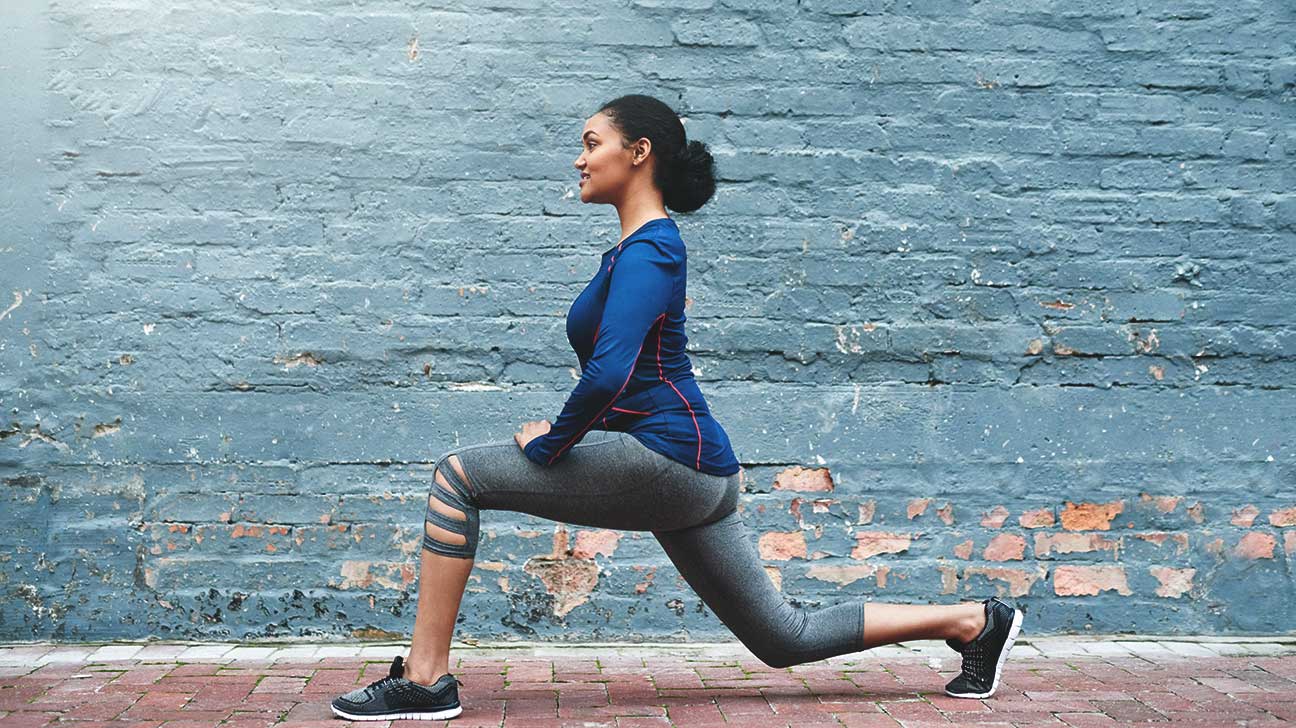
12 of the best pre-run stretches
These static and dynamic warmup stretches target every muscle you’ll be putting through the wringer.
1. Standing quad stretch

This stretch will lengthen those quads (which, in turn, lets your hammies fully activate). Opening up your front leg muscles allows for lovely long strides as you sprint around the track/park/block/booby-trap-filled dungeon.
How to do it:
- Stand straight with toes pointing forward and engage your core muscles.
- Bending at the knee, bring right ankle up toward your right glutes.
- Hold right ankle with right hand.
- Pull ankle toward your butt while pushing your tailbone toward the floor.
- Hold for 1 breath, then repeat as many times as needed (until you feel those front leg muscles stretch out).
- Repeat with the other leg. Alternate as many times as needed.
2. Standing dynamic hamstring/calf stretch
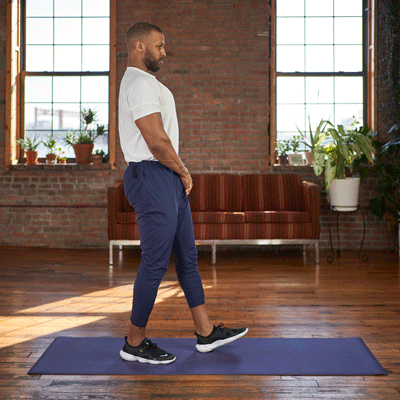
This one’s going to loosen up the backs of your legs, getting your hamstrings and calves revved and ready for your run. A key benefit of this stretch is that by targeting the calves, you reduce strain on the gastrocnemius muscle. This is a big plus, because a strained gastrocnemius can cause a lot of knee problems.
How to do it:
- Stand with feet hip-width apart and bring your right heel 12 inches forward.
- Point your right toes upward while keeping right leg straight.
- Shift your weight onto your left leg. Allow knee to bend slightly and stretch forward.
- Hold for 5 secs. Repeat 3x.
- Repeat with your other leg.
3. Standing hip flexion
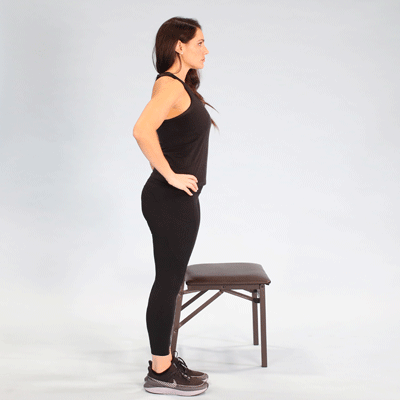
It’s no secret that your hips are up against it when you’re running. Stretches like this get your hip joints nice and loose. Improved mobility in the short term, reduced risk of later-life hip problems in the long term — very nice.
How to do it:
- While standing, shift your weight onto your right leg.
- Bring left knee up until it’s at a 90-degree angle with left hip. Hold for 3–5 seconds.
- Tighten up that core, but keep your pelvis neutral. Hands on hips will help with balance here.
- Repeat 5–10 times before switching sides.
4. Standing IT band stretch
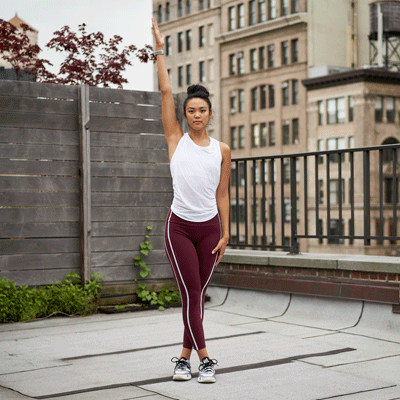
Do you know what your iliotibial band is? The TL;DR is the IT band is a thick band of tendon tissue that runs down your outer thighs, from your hip bones all the way to your shins. A bonus of this stretch is that it also lengthens your tensor fascia latae, an important hip muscle.
How to do it:
- Find a wall/tree/ancient temple statue to balance yourself against, just in case.
- Cross your right ankle in front of your left ankle.
- Using right arm for balance, stretch left arm up over your head, like you’re signaling to a plane.
- Bring left arm over to your right side, allowing your torso to follow.
- Hold for 30 secs, then switch legs and repeat, stretching to the left this time.
5. Standing calf raise
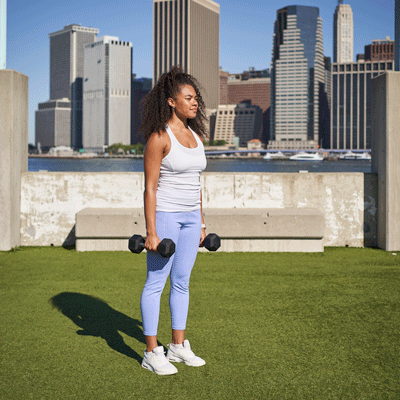
Anyone who has run before knows how harsh it can be on your calves. This simple pre-run stretch ensures your calves are primed and ready for an injury-free good time.
This stretch hits both legs, so there’s no need to alternate. If you want to give your calves an extra kick, you can try holding dumbbells while doing this. One-legged calf raises are also totally a thing.
How to do it:
- Find an edge to stand on — a stair or curb will do. The key is that you’re balancing on the balls of your feet with your heels over the edge. If you don’t have access to some kind of step or (safe) edge, you can do this stretch on a flat surface. (And you can absolutely hold on to something for balance — it’s not cheating.)
- Lift up onto your toes, then lower your heels slowly. You should feel your calves stretch as your heels sink below the edge you’re balancing on.
- Hold for a moment, then lift and repeat, as many times as needed.
6. Lunge with spinal twist

Lunges are an essential pre- and post-run stretch. The side bend lunge is an entry-level lunge that works each leg individually. Why is this important? Because when you’re running, your legs work as individuals. Giving each leg some dedicated warmup time is essential.
How to do it:
- Stand with your feet hip-width apart. Keep that core nice and engaged and your hands on your hips.
- Bring left foot all the way forward until left knee is bent at a 90-degree angle, with left thigh parallel to the floor.
- Let your pelvis sag toward the floor a little, but keep your left leg straight. This will cause your left heel to rise and stretch that calf muscle.
- Support yourself by placing your left hand on the floor.
- Raise right arm overhead, letting your torso twist to the left as you stretch.
- Hold for 5 secs, return to neutral, and repeat on the other side. Continue for 1 minute.
7. Side lunge

The side lunge hits your hip abductors/adductors (aka your inner thighs) and further engages those core stabilizing muscles. The key difference between this and the lunge in #6 is that this is a lateral (sideways) lunge instead of a forward one.
You can add dumbbells to this one for some extra juice.
How to do it:
- Stand with feet a little wider than shoulder-width apart. If you’re feeling a stretch, you’re standing too wide.
- Keep both feet pointed forward and bend your left knee.
- Let your butt stick out and hinge at your hips, then step to the right.
- Make sure your weight follows the motion and shifts over to your right side. Keep your core engaged.
- Return to standing, then repeat for 10 reps. Repeat with your left leg.
8. Arm swing
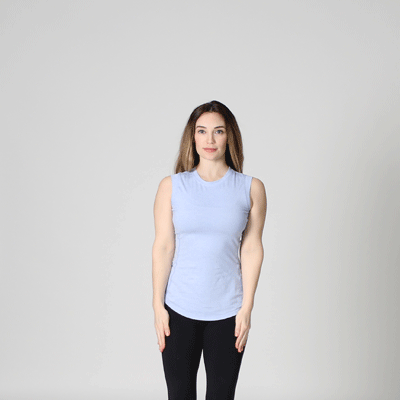
Your legs might be the stars of the running show, but they aren’t the only cast members. Any experienced runner will tell you you’re not running properly if those arms aren’t a little pumped afterward.
That’s exactly what arm swings do: get your arms loose and limber so you don’t get surprised by thoracic outlet syndrome or some other unexpected arm/shoulder/upper-body injury.
How to do it:
- Stand with feet shoulder-width apart.
- You’ll be using both arms at the same time. Raise them up above your head, fully outstretched, almost as if you were … swinging them.
- Allow your arms to fall behind you, again keeping up that straight-armed swing motion.
- Repeat for about 30 seconds, gradually increasing the range and momentum of your swings as you go.
Important note: The goal here isn’t to go wild like a dancer at Burning Man. Keep your swings controlled and mindful. These are stretches, remember. The cardio bit will come afterward, when you’re doing the actual running.
9. Straight-leg lateral swing
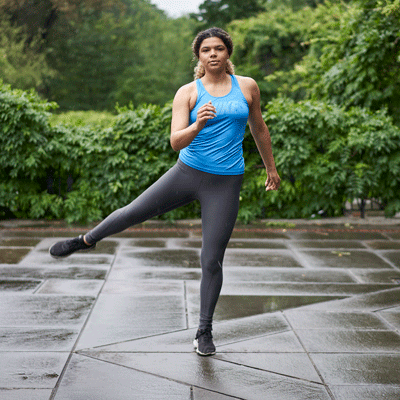
More swinging, but this time we’re going back to your legs. You may need to hold on to something while doing this move, but you might be able to do it freestanding if your balance is A+. Just like the side lunge, this is a lateral stretch that gets your hip abductors/adductors primed.
How to do it:
- Stand straight, holding on to a wall/tree/sacrificial altar in that temple you’re plundering.
- With your weight on your right leg, lift your left one.
- Swing left leg outward to the left. Remember, this is a straight-leg lateral swing. No knee bending.
- In a single smooth motion, swing left leg back, moving it across your body until it’s sticking out to your right side. Keep hips squarely facing forward for maximum benefit.
- Do this 10 times, then repeat with the other leg.
10. Bent-knee forward swing
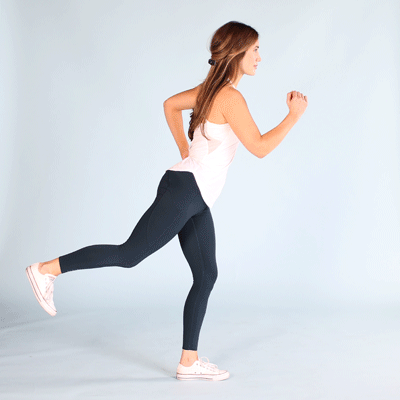
The last swing on the list remains in the leg region, but this time we’re going for some bent-knee forward/backward motion. This stretch is another great one for your hip flexors, which is important since they’re ground zero for a lot of running-related injuries.
How to do it:
- Stand straight, still holding on to your chosen bit of stable background scenery.
- Lift left leg, so you’re standing on your right one.
- Bring left knee up in front of you until it’s bent at a 90-degree angle.
- Allow the lift to continue until your knee is in toward your chest (or as close to it as you can get it). Make sure to keep those hips pointing forward.
- Bring left leg back down and keep going until it’s stretched out behind you.
- Repeat this 10x, then repeat with the other leg. Again, remember that this is a swing — keep your motions fluid and, um, swing-like.
11. High knees
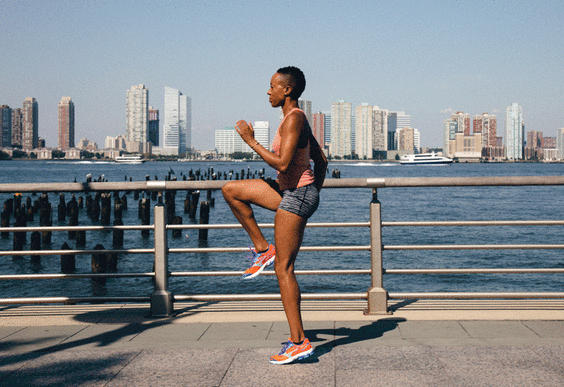
This classic running drill gets those knees high up to your chest, flexing out the last of that stiffness from your hip flexors, ankles, and, of course, knees. It gets that ticker ticking too.
How to do it:
- Stand straight, with both arms bent at 90-degree angles in front of you, and begin gently running/jogging in place.
- While you’re moving, bring your knees up as high as they can go.
- Continue for 30 seconds, break for 15, then continue for another 30 secs.
12. Butt kicks
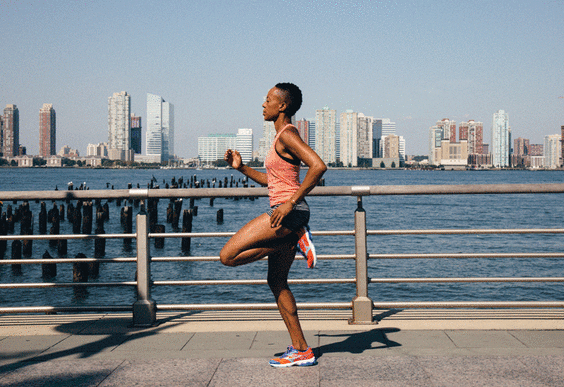
This warmup move works your knees in the opposite direction of high knees, ensuring you’ve got maximum flexibility. It also keeps up that light cardio heart-pumping you’re going to need when you get into your run.
How to do it:
- Start jogging in place with your natural running motion.
- As you jog, bring each heel right up behind you until it makes contact with the corresponding butt cheek.
- Keep this up for 30 seconds, take a 15-second break, then do another 30 secs.
Why you should stretch before a run
Just in case the need for pre-run stretching is news to you, here’s a breakdown of the reasons it’s important:
- It helps your body process oxygen. As outlined by this 2020 research review, proper oxygen consumption is pretty important when you’re running (or doing any other cardio-intensive exercise). Among other things, processing oxygen properly means your body will have what it needs to finish a run.
- It helps you maintain proper circulation. Pre-workout stretches increase blood flow and cardio activity. This is important for obvious reasons.
- It reduces the risk of injury. This goes for both injuries during your run and longer-term injuries that can develop over the course of your running career. This isn’t just limited to your legs, either. Stretching beforehand also decreases the risk of, for example, lower back pain.
- It reduces muscle stiffness and increases flexibility and range of motion. This is a big part of why stretching helps minimize the risk of getting yourself into a running-based physical pickle.
- It improves overall performance. This might seem cliché but it’s true: If you stretch before you run, you’ll run better. It’s that simple. You ever see a stiff Olympian? Exactly.
Why you should stretch after a run too
Cooldown stretches after a run are just as essential for injury prevention. Muscle tightness commonly comes on during or after a run. This stiffness can become a sprain, a tear, or another muscular injury if not attended to.
It might not happen right away, but minor stiff knees in your twenties can lead to more problems later in life. Stretching after exercise is an easy way so significantly reduce this risk.
Remember, pre- and post-workout stretches have different purposes. It’s not as simple as doing your pre-workout stretch routine in reverse. Post-workout stretches should focus on stretching out and relaxing the muscles, bringing your heart rate down, and shifting cramp-making lactic acid.
Case in point: You’ll usually hold post-workout stretches 10–15 seconds longer, and cardio-stimulating exercises like high knees and butt kicks are reserved for pre-run only.
There are conflicting schools of thought on which is more important — pre- or post-running stretches. The answer is simple: They’re both important, and they’re both more effective when done together. Do both.
The bottom line on stretching before running
Stretching before you go for a run is important. If you skip this step, you’re risking both short- and long-term injury. You also won’t run at your full capability, since your body will spend most of the run waking TF up instead of operating efficiently.
Doing both static and dynamic stretches before you run gets your muscles nice and loose, helping to prevent stiffness, soreness, and longer-term injuries. It improves coordination and generally means you’re going to get greater body benefits from your running.
If you run competitively, you’ll be pleased to know that yes, this does mean you’ll run faster (and/or longer, if marathons are more your thing).
Post-run cooldown stretches are just as important. Stretching before AND after a run is the best way to perform at your best, get the most fitness benefits out of your running, and keep your injury risk as low as possible.


0 Commentaires